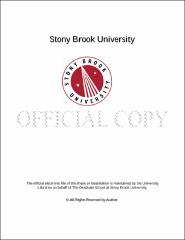| dc.identifier.uri | http://hdl.handle.net/11401/77729 | |
| dc.description.sponsorship | This work is sponsored by the Stony Brook University Graduate School in compliance with the requirements for completion of degree. | en_US |
| dc.format | Monograph | |
| dc.format.medium | Electronic Resource | en_US |
| dc.language.iso | en_US | |
| dc.publisher | The Graduate School, Stony Brook University: Stony Brook, NY. | |
| dc.type | Dissertation | |
| dcterms.abstract | It is hard to imagine a more iconic representation of Peru than the Inca archeological complex of Machu Picchu located in the Cusco region. However, when US explorer, Hiram Bingham, announced that he had discovered the " lost city" in 1911, few would have predicted Machu Picchu's rise to fame during the twentieth century. My dissertation traces the unlikely transformation of Machu Picchu into its present-day role as a modern tourism destination and a representation of Peruvian national identity. Beginning in the 1920s, cusqueño elites embraced the discourse of tourism to re-imagine their region's indigenous heritage not as a sign of backwardness, but as a modern attraction for cultured travelers. Aligning with transnational diplomatic and cultural institutions in the 1930s and 1940s to promote tourism, locals elevated Machu Picchu and cusqueño folklore as symbols of Peru to the world. After the Second World War, locals continued to lobby the state to invest in tourism using recovery efforts following a 1950 earthquake to promote tourism. Finally, in the 1960s and 1970s the Peruvian state, in coordination with UNESCO, spent heavily on developing tourism. Yet, state-led tourism failed to bring economic prosperity to Cusco. Rather than attract elite travelers it encouraged the arrival of hippies and backpackers to the chagrin of locals. Tourism in Cusco nearly collapsed in the 1980s under the pressures of debt crises and political violence. Out of this chaos emerged grassroots and adventure tourism that, by the 1990s, became a widely successful economic model. Recently, however, outside investors and corporations have displaced local participation in the tourism economy. Now, control over the profits and politics of tourism has emerged as a central source of conflict in Cusco. Examining the development of tourism in Cusco, my dissertation reveals how transnational forces can alter the relationship between region and nation in Latin America. Thanks to transnational actors involved in promoting tourism in Cusco, Machu Picchu now serves as a global representation of Peru. However, if tourism has the power to elevate a region's culture and identity, cusqueños also discovered its destructive ability to erode local political and economic independence. | |
| dcterms.abstract | It is hard to imagine a more iconic representation of Peru than the Inca archeological complex of Machu Picchu located in the Cusco region. However, when US explorer, Hiram Bingham, announced that he had discovered the " lost city" in 1911, few would have predicted Machu Picchu's rise to fame during the twentieth century. My dissertation traces the unlikely transformation of Machu Picchu into its present-day role as a modern tourism destination and a representation of Peruvian national identity. Beginning in the 1920s, cusqueño elites embraced the discourse of tourism to re-imagine their region's indigenous heritage not as a sign of backwardness, but as a modern attraction for cultured travelers. Aligning with transnational diplomatic and cultural institutions in the 1930s and 1940s to promote tourism, locals elevated Machu Picchu and cusqueño folklore as symbols of Peru to the world. After the Second World War, locals continued to lobby the state to invest in tourism using recovery efforts following a 1950 earthquake to promote tourism. Finally, in the 1960s and 1970s the Peruvian state, in coordination with UNESCO, spent heavily on developing tourism. Yet, state-led tourism failed to bring economic prosperity to Cusco. Rather than attract elite travelers it encouraged the arrival of hippies and backpackers to the chagrin of locals. Tourism in Cusco nearly collapsed in the 1980s under the pressures of debt crises and political violence. Out of this chaos emerged grassroots and adventure tourism that, by the 1990s, became a widely successful economic model. Recently, however, outside investors and corporations have displaced local participation in the tourism economy. Now, control over the profits and politics of tourism has emerged as a central source of conflict in Cusco. Examining the development of tourism in Cusco, my dissertation reveals how transnational forces can alter the relationship between region and nation in Latin America. Thanks to transnational actors involved in promoting tourism in Cusco, Machu Picchu now serves as a global representation of Peru. However, if tourism has the power to elevate a region's culture and identity, cusqueños also discovered its destructive ability to erode local political and economic independence. | |
| dcterms.available | 2017-09-20T16:53:26Z | |
| dcterms.contributor | Gootenberg, Paul | en_US |
| dcterms.contributor | Zolov, Eric | en_US |
| dcterms.contributor | Larson, Brooke | en_US |
| dcterms.contributor | Poole, Deborah. | en_US |
| dcterms.creator | Rice, Mark | |
| dcterms.dateAccepted | 2017-09-20T16:53:26Z | |
| dcterms.dateSubmitted | 2017-09-20T16:53:26Z | |
| dcterms.description | Department of History. | en_US |
| dcterms.extent | 267 pg. | en_US |
| dcterms.format | Application/PDF | en_US |
| dcterms.format | Monograph | |
| dcterms.identifier | http://hdl.handle.net/11401/77729 | |
| dcterms.issued | 2015-08-01 | |
| dcterms.language | en_US | |
| dcterms.provenance | Made available in DSpace on 2017-09-20T16:53:26Z (GMT). No. of bitstreams: 1
Rice_grad.sunysb_0771E_11829.pdf: 5299029 bytes, checksum: 1b3e66ec023de3b4834fcfc31caf2c88 (MD5)
Previous issue date: 2014 | en |
| dcterms.publisher | The Graduate School, Stony Brook University: Stony Brook, NY. | |
| dcterms.subject | Andes, Cusco, Machu Picchu, Peru, Tourism | |
| dcterms.subject | History | |
| dcterms.title | Selling Sacred Cities: Tourism, Region, and Nation in Cusco, Peru | |
| dcterms.type | Dissertation | |

